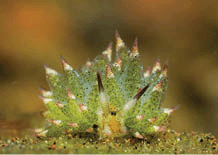Return to 3rd Quarter 2024 articles.



Animals use an enormous number of methods to get nourishment. Harsh environments often require unusual methods, and many times, the animal at the bottom of the food chain is unusual. An excellent example is the leaf slug or leaf sheep (Costasiella kuroshimae). This sea slug is an animal using photosynthesis to secure its nourishment by a method known as kleptoplasty.
Plants serve as the foundation of the food chain, harnessing sunlight through photosynthesis to produce energy. Many animals, such as herbivores, rely on plants to meet their energy needs. Even carnivores indirectly depend on plants, as they consume the herbivores. However, the leaf sheep, through kleptoplasty, bypasses continued reliance on plants, directly using photosynthesis for its energy needs.
Leaf sheep sea slugs are only five to ten millimeters long. They were first discovered off the coast of Japan in 1993 and later found in the Philippines and Indonesia. Their common name derives from their resemblance to a tiny sheep. They feed on algae, which are plants that contain chloroplasts that enable photosynthesis. The leaf sheep retain the chloroplast cells within their bodies, enabling them to use photosynthesis, bypassing the need to eat more algae for over two months. In the food chain, the leaf sheep become food for various fish and other forms of sea life.
The more we learn about the natural world, the more we see unique systems that allow life to exist in symbiotic relationships that give evidence of design. Mindless chance does not provide the best explanation for examples such as leaf sheep. If there were just one such case, you might think it could be chance, but this is just one of a vast number of cases where God's very specialized design allows life to exist.
Picture credits:
https://commons.wikimedia.org/wiki/File:Costasiella_Kuroshimae_(19080120525)_(2).jpg
